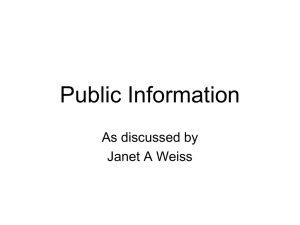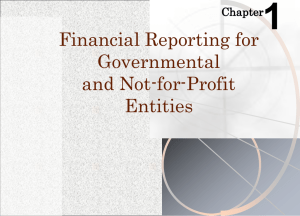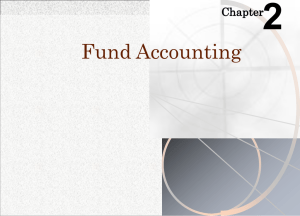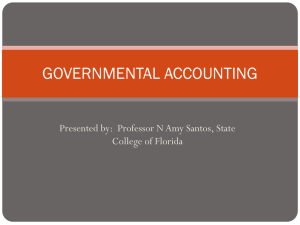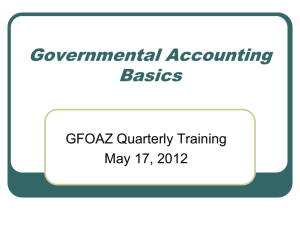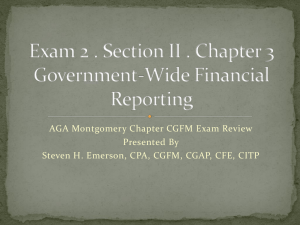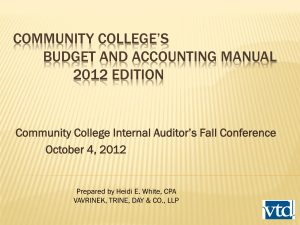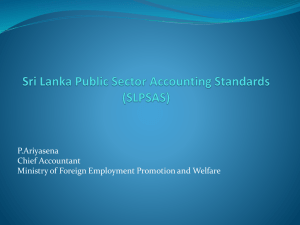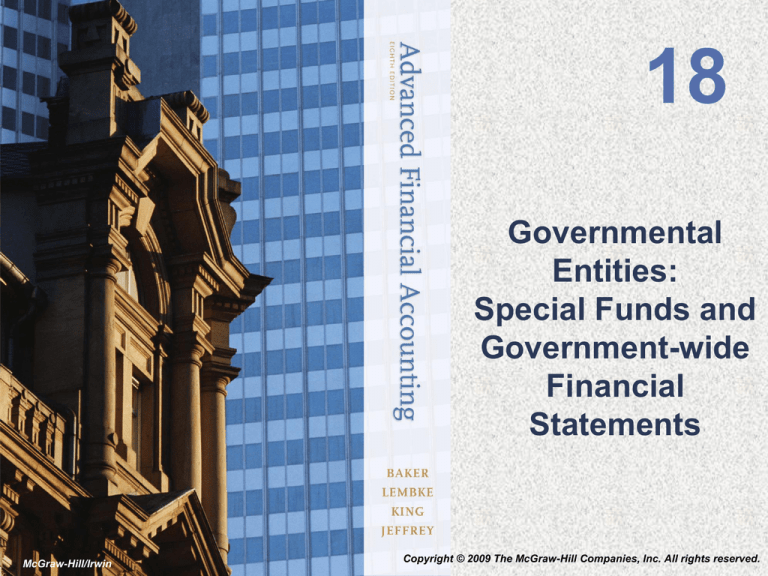
18
Governmental
Entities:
Special Funds and
Government-wide
Financial
Statements
McGraw-Hill/Irwin
Copyright © 2009 The McGraw-Hill Companies, Inc. All rights reserved.
Overview
•
•
A government should establish those funds
required by law and the specific operating
and management needs of the government
entity
A general rule is that all activities should be
accounted for in the general fund unless
specifically required by law or the different
measurement focus used for proprietary
and fiduciary funds
18-2
Overview
18-3
Governmental Funds Worksheets
•
Each of the five governmental funds will
report two fund-based financial statements:
– The balance sheet
– The statement of revenues, expenditures, and
changes in fund balance
18-4
18-5
18-6
Special Revenue Funds
•
•
•
Special revenue funds account for the
proceeds of specific revenue sources that
are restricted for specified purposes
Includes resources and expenditures for
operations, such as public libraries, when a
separate tax is levied for their support
Accounting for special revenue funds is the
same as for the general fund
18-7
Capital Projects Funds
•
Capital projects funds account for financial
resources that are specified for the
acquisition or construction of major capital
facilities or improvements that benefit the
public
– A separate capital projects fund is created at
the time the project is approved and ceases at
its completion
– Uses the modified accrual basis of accounting
18-8
Capital Projects Funds
– No fixed assets or depreciation are recorded
– No long-term debt is recorded
– Typically do not have annual operating
budgets
– A capital budget is prepared as a basis for
selling bonds to finance a project, and the
capital budget is the control mechanism for
the length of the project
– The capital budget for the project may, or may
not, be formally recorded in the accounts
– The fund records capital outlays as
expenditures
18-9
Debt Service Funds
•
•
Debt service funds account for the
accumulation and use of resources for the
payment of general long-term debt principal
and interest
General long-term debt obligations:
–
–
–
–
–
Serial bonds
Term bonds
Special assessment bonds
Notes and warrants
Capital leases
18-10
Debt Service Funds
•
•
The accounting and financial reporting for
debt service funds are the same as for the
general fund
The modified accrual basis of accounting is
used
– Only that portion of the long-term debt that
has matured and is currently payable is
recorded
– Interest payable on long-term debt is not
accrued; interest is recognized as a liability
only when it comes due and payable
18-11
Permanent Funds
•
•
Permanent funds are established in those
cases in which there is a donor restriction
that the fund principal must be preserved
but the income from these permanent funds
is required to be used to benefit the
government’s programs or its general
citizenry
The modified accrual basis of accounting is
used in this fund and the financial
statements for the permanent funds are the
same as for all other governmental funds
18-12
Governmental Funds Financial
Statements
•
The required financial statements are (1)
the governmental funds balance sheet and
(2) the governmental statement of
revenues, expenditures, and changes in
fund balance
– The statements will be prepared for each
individual governmental fund and these
individual fund statements are the foundation
for the financial statements prepared for the
governmental entity
18-13
Governmental Funds Financial
Statements
– The fund-based financial statements for the
governmental entity’s annual report separately
report only major governmental funds, not
necessarily individually each of the five
governmental funds
– GASB 34 specifies that the general fund is
always a major fund
– Some of the other governmental funds may
not be determined to be major funds, and
these non-major funds are aggregated and
reported in a single column as other
governmental funds
18-14
Governmental Funds Financial
Statements
•
Both of the following criteria should be met to be
classified as major :
1. 10 percent criterion: Total assets, liabilities, revenues,
or expenditures/expenses of that individual
governmental or enterprise fund are at least 10
percent of the corresponding total for all funds of that
category or type
2. 5 percent criterion: Total assets, liabilities, revenues,
or expenditures/expenses of the individual
governmental fund or enterprise fund are at least 5
percent of the corresponding total for all governmental
plus enterprise funds combined
18-15
Enterprise Funds
•
Enterprise funds accounts for operations of
governmental units that charge for services
provided to the general public
– They have a measurement focus of all
economic resources and use the accrual basis
of accounting
– They report fixed assets, which are
depreciated, and long-term debt, if issued,
– They focus on income determination and
capital maintenance
18-16
Enterprise Funds
•
The financial statements for proprietary
funds are very similar to those for
commercial entities:
1. The statement of net assets (balance sheet),
2. The statement of revenues, expenses, and
changes in fund net assets (income
statement)
3. The statement of cash flows
•
Budgeting in the proprietary funds also has
the same role as in commercial entities
18-17
Enterprise Funds
•
Financial statements for the proprietary
funds
– If a governmental entity has more than one
enterprise fund, each must be individually
assessed by both the 10 percent criterion and
the 5 percent criterion tests to determine
whether it is a major fund
18-18
Enterprise Funds
•
Statement of net assets
– Proprietary funds report their own fixed
assets, investments, and long-term liabilities
– GASB 34 specifies that the net assets section
be separated into three components:
1. Invested in capital assets, net of related debt
2. Restricted because of restrictions beyond the
government’s control
3. Unrestricted
18-19
Enterprise Funds
•
Statement of revenues, expenses, and
changes
– A separation of operating and nonoperating
revenues and expenses is made to provide
more information value regarding the
operations of the proprietary funds
18-20
Enterprise Funds
•
Statement of cash flows
– Because of the large number of capital asset
acquisition and financing transactions, the
GASB specified four sections:
1. Cash flows from operating activities
2. Cash flows from noncapital financing activities
3. Cash flows from capital and related financing
activities
4. Cash flows from investing activities
18-21
Internal Service Funds
•
Internal service funds account for the
financing of goods or services provided by
one department or agency to other
departments or agencies on a costreimbursement basis
– These services are not available to the
general public, making it different from the
enterprise fund
– Accounting and financial reporting for internal
service funds are the same as for enterprise
funds or for commercial entities
18-22
Internal Service Funds
•
The accrual basis is used to measure
revenue and expenses
– The balance sheet may include fixed assets,
which are depreciated, and long-term debt, if
issued
– The statement of revenue, expenses, and
changes in fund net assets reports the
income for the period
– The statement of cash flows is also required
18-23
Trust Funds
•
•
Trust funds are a fiduciary fund type that
accounts for resources held by a
government unit in a trustee capacity
The governmental unit acts as a fiduciary
for monies or properties held on behalf of
individuals, employees, or other
governmental agencies
18-24
Trust Funds
•
The accrual basis of accounting is used
– The financial statements required are the
statement of fiduciary net assets, and the
statement of changes in fiduciary net assets
– The statement of fiduciary net assets includes
all trusts and agency funds
– The statement of changes in fiduciary net
assets includes only the trust funds because
agency funds do not have a net asset balance
18-25
Trust Funds
•
Private-purpose trust funds account for trust
agreements for which the principal and/or
income benefits specific individuals, private
organizations, or other governments
18-26
Agency Funds
•
Agency funds are a fiduciary fund type that
accounts for resources held by a
governmental unit as a custodial agent for
individuals, private organizations, other
funds, or other governmental units
– Uses the accrual basis of accounting
– Because these funds are custodial in nature,
assets always equal liabilities and there is no
fund equity
– The financial statement for agency funds is
the statement of fiduciary net assets
18-27
The Government Reporting Model
•
•
GASB 34 specifies the reporting model
What organizations comprise the reporting
entity?
– The primary government
– A component unit for which the primary
government is financially accountable
– Any organization that has a significant
relationship with the primary government
18-28
The Government Reporting Model
•
What constitutes financial accountability?
– Financial accountability is evidenced when the
primary government appoints a majority of the
organization’s governing board
– Financial accountability may also exist if the
organization has a separately elected or
appointed board but fiscally depends on the
primary government for the financial
resources required to operate
18-29
The Government Reporting Model
•
What other organizations should be
included in the reporting entity?
– GASB 14 specifies a third category of
organizations to be evaluated to determine if
they are part of the reporting entity with the
primary government
– These are legally separate, tax-exempt
entities for which the primary government is
not financially accountable
18-30
The Government Reporting Model
•
How should the financial results of the
component units be reported?
– A choice between two methods:
•
•
Discrete presentation in a separate column of the
primary government’s financial statements
Blended presentation by combining the
organization’s results into the primary
government’s financial results
18-31
The Government Reporting Model
•
Government financial reports
– The annual report of a governmental entity is
termed the comprehensive annual financial
report (CAFR)
18-32
18-33
The Government Reporting Model
•
Government-wide financial statements
– The government-wide financial statements
include:
•
•
The statement of net assets
The statement of activities
– GASB 34 requires that government-wide
financial statements be prepared on the
economic resources measurement focus with
the accrual basis of accounting
18-34
18-35
18-36
The Government Reporting Model
•
Reconciliation schedules
–
Required to reconcile the net change in the total
amounts reported on the governmental funds
statements with the amounts reported on the
government-wide statements
•
•
•
Reconciliation schedule for Statement of Net Assets
Reconciliation schedule for Statement of Activities
Budgetary comparison schedule
–
This should be presented as required supplementary
information for the general fund and for each special
revenue fund that has a legally adopted annual budget
18-37
The Government Reporting Model
•
Management’s Discussion and Analysis
– MD&A should be included in the required
supplementary information of the governmentwide financial statements to provide an
analytical overview of the government’s
financial and operating activities
•
Notes to the government-wide financial
statements
– GASB 34 specified a number of required note
disclosures
18-38
The Government Reporting Model
•
Interim reporting:
– Governmental entities generally are not
required to publish interim reports, although
many prepare monthly or quarterly reports
– Internal management control instrument
•
Auditing governmental entities
– Most entities are audited annually
– Different from the audit of a commercial entity
– Single Audit Act of 1984
18-39
Additional Considerations
•
•
•
•
Special-purpose governmental entities
Financial reporting for pensions and OPEB
plans
Employer accounting for pensions and
OPEB plan benefits
Accounting for termination benefits
18-40

